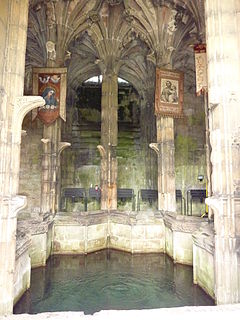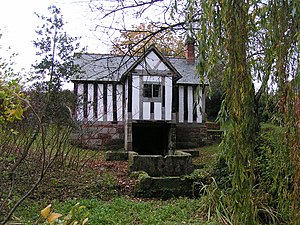
Feastday: November 3
Patron: of Holywell; against unwanted advances
According to legend, she was the daughter of a wealthy resident of Tegeingl, Flintshire, Wales, and the sister of St. Beuno. She was most impressed by Beuno, was supposedly beheaded on June 22 by one Caradog when she refused to submit to him, had her head restored by Beuno, and sometime later, became a nun of the convent of a double monastery at Gwytherin in Denbigshire. She succeeded an Abbess Tenoy, as Abbess and died there fifteen years after her miraculous restoration to life. A spring supposedly springing up where Winifred's head fell, is called Holy Well or St. Winifred's Well and became a great pilgrimage center where many cures have been reported over the centuries. She is also known as Gwenfrewi. Her feast day is November 3.
Welsh Christian martyr
Saint Winifred (or Winefride, Welsh: Gwenffrewi; Latin: Wenefreda) was a Welsh virgin martyr of the 7th century. Her cult was celebrated as early as the 8th century, but became popular in England in the 12th, when her biography (vita) was first written down.
A healing spring at the traditional site of her decapitation and restoration is now a shrine and pilgrimage site called St Winefride's Well in Holywell, Flintshire, Wales and known as "the Lourdes of Wales".
Life and legend
The oldest accounts of the saint's life date to the 12th century. According to legend, Winifred was the daughter of a chieftain of Tegeingl, Welsh nobleman, Tyfid ap Eiludd. Her mother was Wenlo, a sister of Saint Beuno and a member of a family closely connected with the kings of south Wales. Her suitor, Caradog, was enraged when she decided to become a nun, and decapitated her.
A healing spring appeared at where her head fell. Winifred's head was subsequently rejoined to her body due to the efforts of Saint Beuno, and she was restored to life. Seeing the murderer leaning on his sword with an insolent and defiant air, St. Beuno invoked the chastisement of heaven, and Caradog fell dead on the spot, the popular belief being that the ground opened and swallowed him. St. Beuno left Holywell, and returned to Caernarfon. Before he left the tradition is that he seated himself upon the stone, which now stands in the outer well pool, and there promised in the name of God "that whosoever on that spot should thrice ask for a benefit from God in the name of St. Winefride would obtain the grace he asked if it was for the good of his soul."
After eight years spent at Holywell, Winifred received an inspiration to leave the convent and retire inland. Accordingly, St. Winifred went upon her pilgrimage to seek for a place of rest. Ultimately she arrived at Gwytherin near the source of the River Elwy. She later became a nun and abbess at Gwytherin in Denbighshire. More elaborate versions of this tale relate many details of her life, including Winefride's pilgrimage to Rome.
Given the late date of the earliest surviving written accounts of Winifred's life, her existence has been doubted since the 19th century. She is not recorded in any Welsh pedigree of saints nor in the 13th-century calendar of Welsh saints. There is, however, evidence of her cult from centuries before the appearance of her first hagiography. Two small pieces of an oak reliquary from the 8th century were discovered in 1991 and identified based on earlier drawings as belonging to the Arch Gwenfrewi, the reliquary of Winifred. The reliquary probably contain an article of clothing or another object associated with the saint, but not her bones. It provides "good evidence for her having been recognized as a saint very soon after her death", and thus of her historicity. The reliquary may even be "the earliest surviving testimony to the formal cultus of any Welsh saint".
Veneration
Veneration of Winifred as a martyr saint is attested for the 12th century. She is mostly venerated in England, not in Wales, which led Caesar Baronius to list her as an "English saint" in his Roman Martyrology of 1584.
In 1138, relics were carried to Shrewsbury to form the basis of an elaborate shrine. Church of St. Winifred, Stainton is a 12th Century church located in the village of Stainton, South Yorkshire, England.
 Shrewsbury Cathedral
Shrewsbury Cathedral
Cult
 Part of the prologue of a life of St Winifred by Robert of Shrewsbury, Bodleian Mss. Laud c.94.
Part of the prologue of a life of St Winifred by Robert of Shrewsbury, Bodleian Mss. Laud c.94.
The details of St. Winefride's life are gathered from a manuscript in the British Museum, said to have been the work of the British monk, Elerius, a contemporary of the saint, and also from a manuscript life in the Bodleian Library, generally believed to have been compiled (1130) by Robert, prior of Shrewsbury. Prior Robert is generally credited with greatly promoting the cult of St Winifred by translating her relics from Gwytherin to Shrewsbury Abbey and writing the most influential life of the saint. John of Tynemouth also wrote of Winifred.
To further enhance the prestige of the Abbey, Abbot Nicholas Stevens built a new shrine for St Winifred and then had some monks steal the relics of St Beuno from Rhewl and installed them in the abbey church. Although the abbey was fined, it was allowed to keep the relics.
Caxton's 1483 edition of the Golden Legend included the story of Saint Winifred. The following year, he printed a separate "Life" of the saint.
 St Winefride's Well, Holywell
St Winefride's Well, Holywell
The shrine and well at Shrewsbury became major pilgrimage goals in the Late Middle Ages, but the shrine was destroyed by Henry VIII in 1540.
The well at Holywell, originally formed from a mountain spring, is housed below the town on the side of a steep hill. The shrine of St. Winifride (Gwenffrwd or Gwenfrewi), regarded as one of the finest surviving examples of a medieval holy well in Britain. The Well precinct also houses an Interpretive Exhibition setting forth the story of the saint and her shrine in detail; and the Victorian former custodians' house has been converted to house a museum of the pilgrimage.
 St Winifred's Well, Woolston, Shropshire
St Winifred's Well, Woolston, Shropshire
Another well named after St Winifred is in the hamlet of Woolston near Oswestry in Shropshire. It is thought that on her way to Shrewsbury Abbey, Winifred's body was laid here overnight and a spring sprang up out of the ground. The water is supposed to have healing powers and be good at healing bruises, wounds and broken bones. The well is covered by a 15th-century half-timbered cottage. The water flows through a series of stone troughs and into a large pond, which then flows into a stream. The cottage is in a quiet, peaceful setting in the middle of the countryside, and is maintained by the Landmark Trust.
Another spring supposedly arising from the laying down of Winifred's body is at Holywell Farm, midway between Tattenhall and Clutton, Cheshire. There is a spring in the garden of this non-working farm which supplies two houses with their drinking water.
A spring on Lansdown Hill, Bath was known as St. Winifred's Spring and has given its name to nearby Winifreds Lane. There appears to be no known connection to the life of the saint, but its waters were once supposed to help women conceive.
A Norman church dedicated to Saint Winifred can be found in the village of Branscombe, Devon. There is some archaeological evidence to suggest an earlier Saxon church may have occupied the site.
Roman Martyrology
In the 2004 edition of the Roman Martyrology, Winefride is listed under 2 November with the Latin name Winefrídae. She is listed as follows: 'At the spring located at Holywell in Wales, St Winefride the Virgin, who is outstanding in her witness as a nun'. Thus Winifred is officially recognised by the Vatican as a person with a historical basis, who lived an exemplary religious life, but with no discussion of miracles which she may have performed or been healed by. As a first-millennium saint, she is recognised as a saint by popular acclaim, rather than ever being formally canonized.
In the current Roman Catholic liturgical calendar for Wales, she is commemorated on 3 November, since 2 November is designated as All Souls' Day.
Iconography
Her representation in stained glass at Llandyrnog and Llanasa focusses on her learning and her status as an honorary martyr, but the third aspect of her life, her religious leadership, is also commemorated visually. On the seal of the cathedral chapter of St Asaph (now in the National Museums and Galleries of Wales, Cathays Park, Cardiff), she appears wimpled as an abbess, bearing a crozier, symbol of leadership and authority and a reliquary.
References in fiction
St. Winifred's Well is mentioned in the medieval poem Sir Gawain and the Green Knight.
William Rowley's seventeenth century comedy A Shoemaker a Gentleman dramatizes Saint Winifred's story, based on the version in Thomas Deloney's story The Gentle Craft (1584).
English poet Gerard Manley Hopkins memorialized Saint Winifred in his unfinished drama, St Winifred's Well.
The moving of Winifred's bones to Shrewsbury is fictionalized in A Morbid Taste for Bones, the first of Ellis Peters' Brother Cadfael novels, with the plot twist that her bones are secretly left in Wales, and someone else is put into the shrine. Saint Winifred is an important "character" in all the books in the Brother Cadfael series. The celebration of her Feast Day provides the setting for two of the novels, The Rose Rent and The Pilgrim of Hate. The casket is actually stolen from its shrine in The Holy Thief, and the campaign to find and restore it propels the action. Throughout the series, the protagonist, Brother Cadfael - a Welsh monk at the English monastery at Shrewsbury - has a kind of "special understanding" with the saint, whom he affectionately calls "The Girl".
Australian novelist Gerald Murnane makes reference to St. Winifred in his novel, Inland.
A statue of St. Winifred stands overlooking the Hudson River in Hudson, New York, U. S. A.





